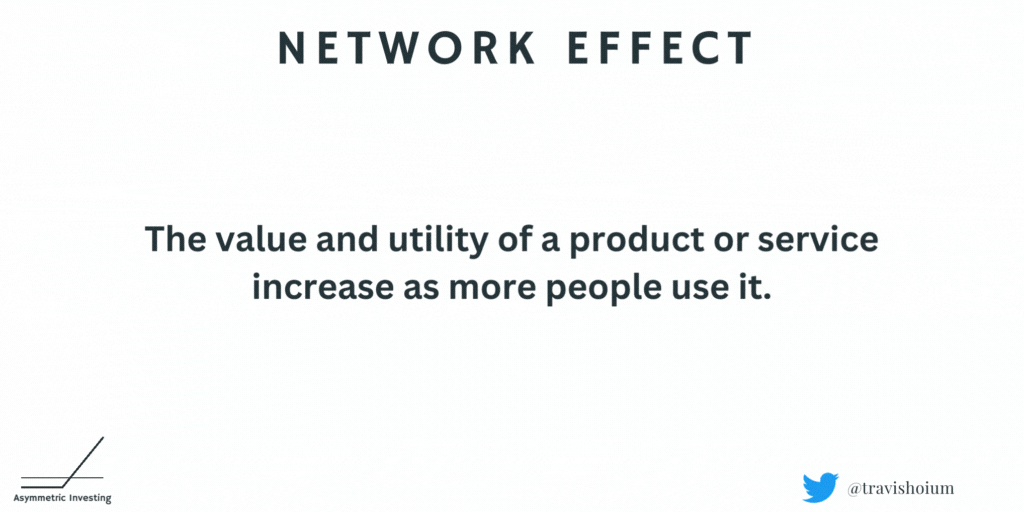One of the things I look for in an asymmetric investing opportunity is a winner take all market. These markets can be big or small but they naturally tend toward one company extracting all of the value.
Here’s a little bit of what I’m looking for in winner take all markets and examples in the Asymmetric Investing Universe.
It’s value that matters
What we’re looking for is a company that extracts all of the value in a market. This doesn’t mean there are no competitors or that a company has monopoly power, it means that the profits flow disproportionately to one company.
Apple is a great recent example of a company that extracts a vast majority of the value in the smartphone business, but it has less than a 50% market share. In other cases, like Google’s search business, market share may be over 90%.
Characteristics of Winner Take All markets
2-Sided Market: A group of buyers and a group of sellers connected by a company in the middle. Airbnb is an obvious 2-sided market and Amazon is now a 2-sided market for buyers and third-party sellers.
Network Effects: The more users there are in a network the more attractive the network is. Microsoft used the network effect to dominate PCs. Uber is a recent example of a network effect because it has more drivers in most areas than Lyft, which attracts more riders, which in turn attracts drivers looking to maximize their own revenue.

Aggregation: A company earns a large user base and then aggregates together many suppliers. More on this below.
Regulatory Lock-In: Supply is limited because regulation limits competition.
In reality, these concepts are often mixed and matched in winner-take-all markets. For example, Google search is clearly an aggregator between websites (suppliers) and users, but its advertising business model is a 2-sided market that’s displayed alongside search results.
The Internet and Aggregation Theory
One of the most influential people in my thinking over the past decade has been Ben Thompson, who pioneered the concept of Aggregation Theory.
Aggregation Theory is a completely new way to understand business in the Internet age. Business schools suggest that with the right frameworks, an executive can understand how to manage all kinds of problems: what happens, though, when many of the inputs to those frameworks are zero?
Zero distribution costs. Zero marginal costs. Zero transactions. This is what the Internet enables, and it is completely transforming not just technology companies but companies in every single industry. Old moats are gone — and new ones can be built — and Aggregation Theory helps you identify both.
Whereas the physical age was dominated by companies who controlled supply (ex. Budweiser, Kraft, P&G) the digital age is dominated by companies who control demand. Users CHOOSE Google, Netflix, and Facebook every day over Bing, Peacock, and MySpace, which drives revenue and reinvestment and ultimately a better product that users choose again the next day. It’s a virtuous cycle like a network effect, but instead of the network being the attraction, the superior user experience is the attraction for aggregators.
We’re buying winner take all stocks
The Asymmetric Universe is full of companies in a potential winner take all markets.
Cruise: Now that Uber has clearly crushed Lyft, I think it’s clear the ride-sharing business is a winner take all market. Autonomous ride-sharing will likely be no different. Cruise could brute force its way into a network effect win, flooding the market with supply, attracting demand away from Uber, and ultimately any autonomous ride-sharing competition.
Spotify: Spotify is an audio aggregator and is the one company that focuses solely on audio and while Apple, Google, Amazon, and even YouTube. That focus on the user experience has driven Spotify’s growth and I think bolting on advertising as a 2-sided market will ultimately make the economics of Spotify so much better for creators that they start moving there exclusively. YouTube has shown the way in video.
Peloton: The digital fitness business is a network effects business with some aggregation mixed in. If Peloton attracts more users than competitors it can invest in more content, which will attract more users, and so on. It’s the Netflix of fitness and it’s no surprise that its CEO spent over a decade building Netflix’s business.
I think in the case of each, the natural end state of the market is for one winner to emerge. If that’s the case, these stocks have asymmetric potential.
Part of a framework
Asymmetric Investing isn’t about hard and fast rules, it’s about using tailwinds of great business models and favorable market dynamics to our advantage. Disproportionately investing in winner take all markets gives us a greater probability of finding stocks with an asymmetric return.
Disclaimer: Asymmetric Investing provides analysis and research but DOES NOT provide individual financial advice. Travis Hoium may have a position in some of the stocks mentioned. All content is for informational purposes only. Asymmetric Investing is not a registered investment, legal, or tax advisor or a broker/dealer. Trading any asset involves risk and could result in significant capital losses. Please, do your own research before acquiring stocks.

